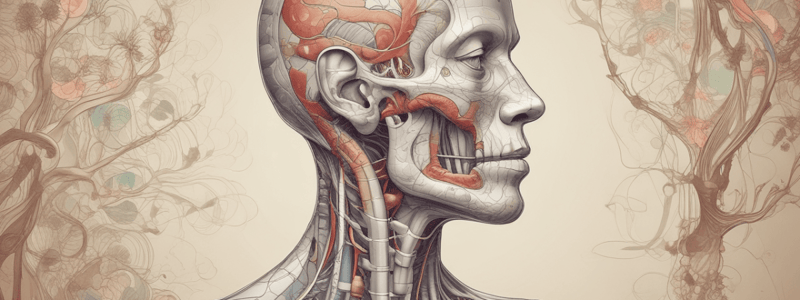Podcast
Questions and Answers
What is the primary function of the respiratory system in conjunction with the heart?
What is the primary function of the respiratory system in conjunction with the heart?
- To remove carbon dioxide from the body
- To digest food in the stomach
- To bring oxygen from air to blood and then to tissues and organs (correct)
- To pump blood throughout the body
What is the main role of the diaphragm in the respiratory system?
What is the main role of the diaphragm in the respiratory system?
- To enhance ventilation during high oxygen demand
- To filter out viruses and bacteria from the air
- To stabilize the thoracic cavity
- To pull air into the airways by creating negative pressure in the chest (correct)
What is the site of gas exchange in the lungs?
What is the site of gas exchange in the lungs?
- Between the nasopharynx and oropharynx
- Between the trachea and bronchi
- Between the alveoli and capillaries (correct)
- Between the bronchioles and diaphragm
Why are older patients at a higher risk of complications?
Why are older patients at a higher risk of complications?
Why should individuals with dark skin have their sclera and mucous membranes assessed?
Why should individuals with dark skin have their sclera and mucous membranes assessed?
Flashcards are hidden until you start studying
Study Notes
Importance of Oxygen
- Oxygen is essential for organs to function and the body to stay alive
Respiratory System Components
- The respiratory system works with the heart to bring oxygen from air to blood to tissues to organs
- Lungs and chest wall play a crucial role in inspirations and expiration of air
- Respiratory accessory muscles stabilize thoracic cavity and enhance ventilation during high oxygen demand
Division of the Respiratory System
- Upper respiratory tract includes the nasopharynx and oropharynx
- Lower respiratory tract includes the trachea, bronchi, bronchioles, and lungs
Diaphragm Function
- Diaphragm: a muscle at the base of the lungs, pulls air into airways by creating negative pressure in the chest
Physiology of the Respiratory System
- Gas exchange in lungs takes place in lung tissue between alveoli and capillaries
- Gas exchange involves the exchange of carbon dioxide and oxygen
- Lungs are sponge-like, elastic, cone-shaped organs in the chest cavity
Airways and Defense
- Airways have protective mechanisms against viruses and bacteria
Factors Affecting Respiratory Health
- Older patients are at higher risk of complications due to genetics and environment
- Women have greater bronchial hyperreactivity and larger airways, increasing the risk of rapid lung function decline
- Individuals with dark skin usually show lower oxygen saturation
- Assess their sclera and mucous membranes for paleness and cyanosis
Studying That Suits You
Use AI to generate personalized quizzes and flashcards to suit your learning preferences.




